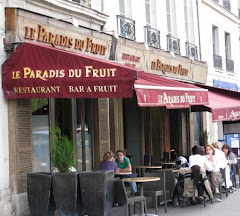The tasting took place in the little house you first encounter as you drive in, and it was packed! I counted at least 100 people at one point, most not from CRFG, and more kept coming. I asked Jeff Moersfelder if he knew why there were so many, and he said it was partly that more people were growing pomegranates these days (15,000 acres in the Central Valley, way up from just a few years ago) and the growers were passing the word on to their neighbors, partly that the word went around in UC Extension circles, and, especially, among the Master Gardeners. In any case, it was quite a mob.

They had laid out a lovely display of 17 pomegranates (bowls of arils and whole fruit) and half a dozen non-astringent persimmons (slices, whole fruit, and beautiful fall foliage) on tables in the middle of the room. There were forms for taking notes, and a tally sheet where they asked people to write their favorites. It looked as though the pomegranates Ariana , Ink, and Parfianka were in the lead, although my favorite was Molla Nepes. I liked that one because the flavor was strong, not too sweet, and had a good “sustain,” whereas the others faded quickly. My favorite from last year, Al-sirin-nar, was not on the table this time. Izu was the clear favorite among the persimmons.

Malli Aradhya spoke very briefly. He said the pomegranate has been around for at least 10,000 years. There are pomegranates that can grow in almost any climate, and yet all that variety is contained within only one species, the only one in the genus Punica. You can read more about their collection
here.After an hour or so they began loading up the vans, to ferry people out to the trees of pomegranates and persimmons, where we were invited to take as much fruit as we wanted. The only request was that people not take too much from any one tree, so that everyone could get some of the good ones. Some people managed to sneak out there in their private cars, and some were so impatient they walked rather than wait for the vans, which were constantly shuttling people back and forth. Some people took home buckets and buckets of fruit, some just a few, but for all, as usual, it was a real treat to be able to stroll through all the trees and see the many varieties of fruit “on the hoof.”
Malli said, seeing the huge turnout, that they were thinking of turning the tasting into a pomegranate festival. Click
here to go to the website of the Wolfskill germplasm repository.

Aftermath.




